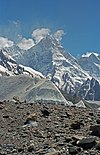
Gilgit-Baltistan, also known as the Northern Areas, is a region in Pakistan. Here are some key points about it:
- Location: It lies in the northern part of the larger Kashmir region.
- Borders:
- To the south, it shares a border with Azad Kashmir.
- To the west, it borders the province of Khyber Pakhtunkhwa.
- The Wakhan Corridor of Afghanistan lies to its north.
- To the east and northeast, it shares a border with the Xinjiang region of China.
- Finally, to the southeast, it is adjacent to the Indian-administered union territories of Jammu and Kashmir and Ladakh.
Gilgit-Baltistan has been at the center of territorial disputes between India and Pakistan since 1947 and between India and China since 1959. It’s a region of great natural beauty and cultural significance.
- Gilgit-Baltistan, often called “Pakistan-administered Kashmir,” is a region in Pakistan.
- It’s six times larger than Azad Kashmir in terms of geographical area.
- Originally known as the Northern Areas, it gained limited autonomy in 2009 under the name “Gilgit-Baltistan”.
- The population has differing views on integration with Pakistan proper.
- In 2020, it was announced that Gilgit-Baltistan would attain provisional provincial status after the 2020 Gilgit-Baltistan Assembly election.
- Area: It covers over 72,971 square kilometers and is characterized by rugged mountains.
- Population: Around 1.8 million people reside there.
- Capital: The capital city is Gilgit, home to approximately 216,760 inhabitants.
- Economy: Agriculture and tourism are key contributors to the economy.
- Natural Wonders:
- Mountains: Gilgit-Baltistan boasts five eight-thousanders, including the famous K2.
- Glaciers: It hosts three of the world’s longest glaciers outside the polar regions.
- Tourism: Trekking and mountaineering are popular activities in this breathtaking region.









